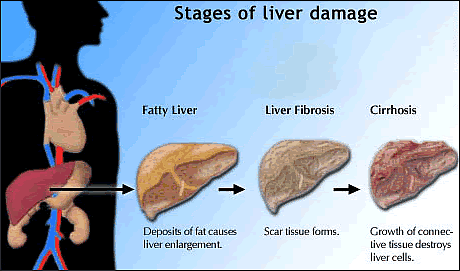By
Liz Highleyman
Over
years or decades, chronic hepatitis B can lead to decompensated
liver disease, characterized by symptoms such as ascites
(abdominal fluid accumulation), portal vein hypertension,
and hepatic encephalopathy.
People
with advanced liver disease are considered difficult to
treat, but this population has an urgent need for effective
therapy to control viral replication and slow further progression
of liver damage. A growing body of research has looked at
antiviral therapy for patients with end-stage liver disease.

Yun-Fan
Liaw from Chang Gung Memorial Hospital in Taiwan and colleagues
conducted a study to compare the safety and tolerability
of tenofovir, tenofovir plus emtricitabine (the 2 drugs
in the Truvada
coformulation approved for HIV treatment), and entecavir.
This
Phase 2 study included 112 chronic hepatitis B patients
with decompensated liver disease. At baseline the median
Child-Turcotte-Pugh (CTP) score was 7 and median MELD scores
ranged from 10.5 to 13.0. Most participants (84%) were men,
the median age was 52 years, just over half were Asian,
and 65% were initially hepatitis B "e" antigen
(HBeAg) negative. About one-third had creatinine clearance
suggesting impaired kidney function at baseline; advanced
liver disease is a risk factor for kidney dysfunction and
tenofovir can cause kidney problems in at-risk individuals.
Participants
were randomly allocated (2:2:1) to the 3 treatment arms.
None had previously used the study drugs; entecavir recipients
who previously used or were resistant to lamivudine
(Epivir-HBV) took a higher dose. The investigators primarily
looked at safety, in particular "tolerability failure"
-- adverse events that resulted in permanent treatment discontinuation
-- and markers of kidney function.
They
also assessed response based on HBV viral load suppression,
ALT liver enzyme normalization, and HBeAg loss and seroconversion.
Patients with insufficient viral suppression (>
400 copies/mL) at weeks 8 or 24 or later could begin open-label
tenofovir/emtricitabine, but were considered "failures"
for the 48-week efficacy analysis.
Results
 |
Tolerability
failure was infrequent and statistically similar in
all study arms: 6.7% with tenofovir monotherapy, 4.4%
with tenofovir/emtricitabine, and 9.1% with entecavir. |
 |
Overall,
8 patients taking tenofovir, 3 taking tenofovir/emtricitabine,
and 3 taking entecavir discontinued their assigned study
drug prior to week 48; 10 switched to open-label tenofovir/emtricitabine. |
 |
Protocol-defined
kidney impairment was also uncommon, occurring in 8.9%,
6.7%, and 4.5%, respectively -- not a significant difference. |
 |
Most
participants across all study arms reported adverse
events, but adverse event profiles and laboratory abnormalities
were consistent with advanced liver disease, with no
unexpected safety signals. |
 |
6
patients died (no deaths considered related to study
drugs) and 6 received liver transplants with no HBV
recurrence. |
 |
At
week 48, similar proportions of patients taking tenofovir
(70.5%) and entecavir (72.7%) had HBV DNA < 400 copies/mL,
rising to 87.8% in the tenofovir/emtricitabine combination
arm. |
 |
These
proportions rose to 76.7%, 87.8%, and 85.7%, respectively,
when participants who switched to open-label tenofovir/emtricitabine
were included. |
 |
Similarly,
57% taking tenofovir and 55% taking entecavir had normal
ALT, rising to 76% in the combination arm. |
 |
21%
of tenofovir recipients and 27% of tenofovir/emtricitabine
recipients experienced HBeAg loss, compared with none
of the entecavir recipients. |
 |
Corresponding
rates of HBeAg seroconversion were 21%, 13%, and 0%,
respectively. |
 |
CTP and MELD scores improved in all treatment arms.
|
 |
No
participants developed resistance to any study drug. |
Based
on these findings, the authors wrote, "All treatments
were well tolerated in patients with decompensated liver
disease due to chronic hepatitis B with improvement in virologic,
biochemical, and clinical parameters."
"Although
the study was not designed to detect differences in efficacy
among the 3 treatment regimens, standard chronic hepatitis
B efficacy assessments (e.g., viral suppression, normalization
of ALT, HBeAg/HBsAg loss, and seroconversion) were generally
improved at 48 weeks in the majority of patients in each
treatment group, as were measures of severity of liver disease
and dysfunction (CTP and MELD scores)," they elaborated
in their discussion. "As anticipated, each treatment
arm produced reductions in serum HBV DNA and normalization
of ALT levels consistent with results obtained in chronic
hepatitis B patients without decompensation."
"The
percentages of patients with confirmed changes in serum
creatinine and/or serum phosphorus were not significantly
different among patients who received [tenofovir] compared
to [entecavir], suggesting similar renal [kidney] safety,"
they added.
"In
summary, both [tenofovir]-containing regimens were well
tolerated in these decompensated chronic hepatitis B patients,
with no significant differences compared to [entecavir]
with respect to tolerability failures or confirmed changes
in renal parameters," the researchers concluded. "These
data demonstrate the safety of these treatments through
48 weeks in patients with decompensated chronic hepatitis
B and evident therapeutic benefit in all groups."
Investigator
affiliations: Liver Research Unit, Chang Gung Memorial Hospital,
Chang Gung University College of Medicine, Taipei, Taiwan;
Department of Internal Medicine, Chang Gung Memorial Hospital,
Kaohsiung Medical Center, Chang Gung University College
of Medicine, Kaohsiung, Taiwan; Ege Universitesi Tip Fakultesi
Hastanesi, Izmir, Turkey; Ippokration General Hospital of
Athens, Athens, Greece; Toronto General Hospital, Toronto,
Ontario, Canada; National Chen Kun University Hospital,
Tainan, Taiwan; Hospital of Infectious Diseases, Warsaw,
Poland; Virginia Mason Medical Center, Seattle, WA; Gordon
and Leslie Diamond Centre, Vancouver, BC, Canada; Hospital
General Universitari Vall d'Hebron, Barcelona, Spain; Hospital
La Fe, Valencia, Spain; Charite Campus Virchow-Klinikum,
Berlin, Germany; Gilead Sciences, Durham, NC; University
of Miami School of Medicine, Miami, FL.
1/18/11
Reference
Y-F Liaw, I-S Sheen, C-Mo Lee, and others. Tenofovir
disoproxil fumarate (TDF), emtricitabine/TDF, and entecavir
in patients with decompensated chronic hepatitis B liver
disease. Hepatology 53(1): 62-72 (Abstract).
January 2011.
